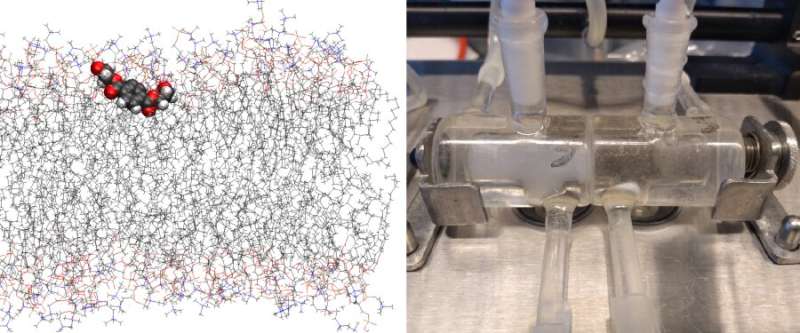Nano-sized plastics may enter and permeate cell membranes

The occurrence of microplastics in nature has been studied extensively, also at the University of Eastern Finland. However, little is known about the health effects of microplastics, and understanding of their transport into the human body is also lacking. Any adverse health effects possibly associated with plastics may be caused by the plastic compound itself, or by the environmental toxins it carries. Many known fat-soluble environmental toxins and heavy metals are known to be able to attach to the surface of small plastic particles. This is why it is important to investigate the transport mechanisms of microplastics into the human body. However, not enough research methods have been developed for the study of this transport. Another key challenge in microplastics research is the lack of standardized methods.
With the help of molecular modeling, researchers at the University of Eastern Finland’s School of Pharmacy analyzed the behavior and transport of nano-sized microplastics in bilayer membranes which mimic cell membranes. The researchers performed simple molecular dynamics simulations using well-known and widely used polyethylene (PE) and polyethylene terephthalate (PET) particles.
The cell membrane permeability of pulverized PE and PET plastics was also examined using the Parallel Artificial Membrane Permeability Assay method, PAMPA. The method is usually used to investigate passive absorption of medicines, but it hasn’t been used to study microplastics before. The PAMPA method was used to investigate the amount of matter permeating the membrane. The amount of plastic permeating the artificial membrane was measured by NMR spectroscopy at certain intervals.
In both experiments, the movement of molecules was controlled only by concentration differences on different sides of the membrane, and by occasional movement induced by heat. In other words, the methods provided information on the passive permeation of molecules through the membranes.
In the computer simulations, PE particles were found to prefer the center of the lipid membrane as their location. In the PAMPA experiments, PE plastic partially permeated the membrane, but membrane permeability slowed down significantly over time, probably due to the accumulation of plastic in the membrane. In the simulations, the preferred location of PET particles was, to a certain degree, the surface part of the membrane, and in the experiments, they permeated the membrane fairly well. According to this study, the properties of the membrane structures were not significantly affected by individual plastics.
The study provides a starting point for the further development of computer simulations and experimental methods for the needs of microplastics research. Significantly more information is still needed on the active transport of microplastics, such as their binding to transporter proteins, possible phagocytosis, and toxic effects on cells.
Microplastics are widespread in soils of tropical areas
Joni Järvenpää et al, PE and PET oligomers’ interplay with membrane bilayers, Scientific Reports (2022). DOI: 10.1038/s41598-022-06217-4
Citation:
Nano-sized plastics may enter and permeate cell membranes (2022, February 17)
retrieved 17 February 2022
from https://phys.org/news/2022-02-nano-sized-plastics-permeate-cell-membranes.html
This document is subject to copyright. Apart from any fair dealing for the purpose of private study or research, no
part may be reproduced without the written permission. The content is provided for information purposes only.
For all the latest Science News Click Here
For the latest news and updates, follow us on Google News.

